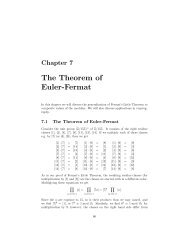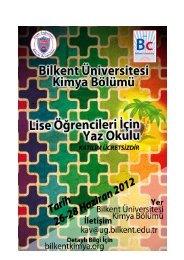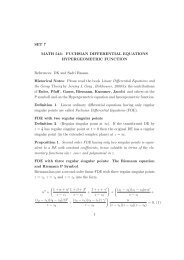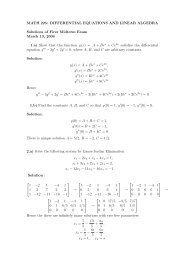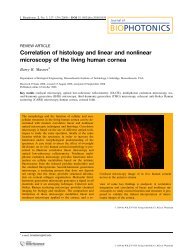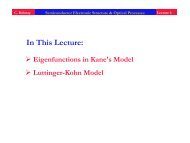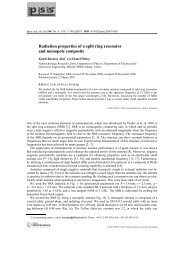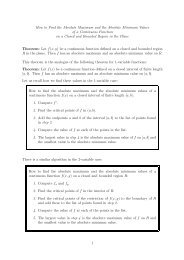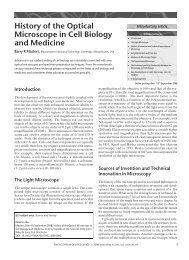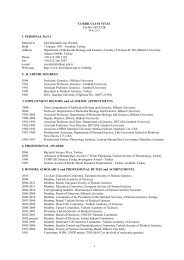Introduction to the English Edition of Hilbert's Zahlbericht
Introduction to the English Edition of Hilbert's Zahlbericht
Introduction to the English Edition of Hilbert's Zahlbericht
You also want an ePaper? Increase the reach of your titles
YUMPU automatically turns print PDFs into web optimized ePapers that Google loves.
this <strong>the</strong>orem has been somewhat neglected. This is also demonstrated by <strong>the</strong> fact that<br />
Hilbert’s pro<strong>of</strong> <strong>of</strong> this <strong>the</strong>orem has not been simplified in 100 years. Even worse: it was<br />
only in 1987 that Lawrence Washing<strong>to</strong>n 33 noticed a gap in it — which is, however, easy<br />
<strong>to</strong> fix.<br />
Hilbert’s Satz 90. Again it was Kummer 34 who discovered (in <strong>the</strong> special case <strong>of</strong> Kummer<br />
extensions <strong>of</strong> Q(ζp)) what is probably <strong>the</strong> most famous <strong>the</strong>orem from <strong>the</strong> <strong>Zahlbericht</strong>. It<br />
is hardly necessary <strong>to</strong>day <strong>to</strong> recall that E. Noe<strong>the</strong>r generalized Satz 90 considerably;<br />
in cohomological formulation, her result reads H 1 (G, K × ) = 1, where K/k is a normal<br />
extension <strong>of</strong> number fields with Galois group G. Satz 90 is <strong>the</strong> statement H −1 (G, K × ) = 1<br />
for cyclic G which follows from H 1 (G, K × ) = 1 using <strong>the</strong> periodicity <strong>of</strong> Tate’s cohomology<br />
groups for cyclic G.<br />
Hilbert’s Satz 91 on <strong>the</strong> existence <strong>of</strong> relative units was <strong>to</strong> be <strong>the</strong> first in a series <strong>of</strong> generalizations<br />
<strong>of</strong> Dirichlet’s unit <strong>the</strong>orem. 35 A similar result had been proved by Kummer 36 in<br />
a slightly different form. The <strong>the</strong>orem is contained implicitly in <strong>the</strong> index computations<br />
in Hasse’s <strong>Zahlbericht</strong> (Ia, §12; Fußnote 25).<br />
Hilbert’s Satz 92. Once more, this is a result which was inspired by work <strong>of</strong> Kummer. 37 In<br />
cohomological form, <strong>the</strong> statement reads H −1 (G, EK) = 1 (here K/k is a cyclic extension<br />
<strong>of</strong> prime order p and Galois group G). Today this is part <strong>of</strong> <strong>the</strong> standard <strong>the</strong>orems in class<br />
field <strong>the</strong>ory known as <strong>the</strong> “Herbrand index <strong>of</strong> <strong>the</strong> unit group”, which says that in fact<br />
# H −1 (G, EK) = p · (Ek : NEK) for cyclic extensions <strong>of</strong> number fields that are unramified<br />
everywhere.<br />
Hilbert’s Satz 94. This is a forerunner <strong>of</strong> <strong>the</strong> principal ideal <strong>the</strong>orem <strong>of</strong> class field <strong>the</strong>ory.<br />
It does not, however, contain Satz 94 as a special case. In contrast <strong>to</strong> Theorems 89–92,<br />
Satz 94 cannot be traced back <strong>to</strong> Kummer. In fact, it is very likely that Kummer did<br />
not even think about <strong>the</strong> possibility <strong>of</strong> ideal classes becoming principal in extensions: his<br />
invalid pro<strong>of</strong> 38 that <strong>the</strong> class number <strong>of</strong> cyclo<strong>to</strong>mic fields is divisible by <strong>the</strong> class number<br />
33L.C. Washing<strong>to</strong>n, Stickelberger’s <strong>the</strong>orem for cyclo<strong>to</strong>mic fields, in <strong>the</strong> spirit <strong>of</strong> Kummer and Thaine,<br />
Théorie des nombres, Quebec, Canada 1987, 990–993 (1989)<br />
34E.E. Kummer, Über eine besondere Art, aus complexen Einheiten gebildeter Ausdrücke, Collected<br />
Papers I, 552–572; in particular p. 553, and Über die allgemeinen Reciprocitätsgesetze unter den Resten<br />
und Nichtresten der Potenzen, deren Grad eine Primzahl ist, Collected Papers I, 699–839; in particular<br />
p. 754<br />
35See for instance J. Herbrand, Sur les unités d’un corps algébrique, C. R. Acad. Sci. Paris 192 (1931),<br />
24–27; and E. Artin, Über Einheiten relativ galoisscher Zahlkörper, J. Reine Angew. Math. 167 (1932),<br />
153–156.<br />
36E.E. Kummer, Über die allgemeinen Reciprocitätsgesetze unter den Resten und Nichtresten der Potenzen,<br />
deren Grad eine Primzahl ist, Collected Papers I, 699–839; in particular pp. 785–792<br />
37E.E. Kummer, Zwei neue Beweise der allgemeinen Reciprocitätsgesetze unter den Resten und<br />
Nichtresten der Potenzen, deren Grad eine Primzahl ist, Collected Papers I, 842–882.<br />
38E.E. Kummer, Bestimmung der Anzahl nichtäquivalenter Klassen für die aus λten Wurzeln der<br />
Einheit gebildeten complexen Zahlen und die idealen Fac<strong>to</strong>ren derselben, Collected Papers I, 299–322; in<br />
particular, p. 320–322. Weil remarks in this connection (ibid, p. 955): “In o<strong>the</strong>r contexts, <strong>of</strong> course, he<br />
10



